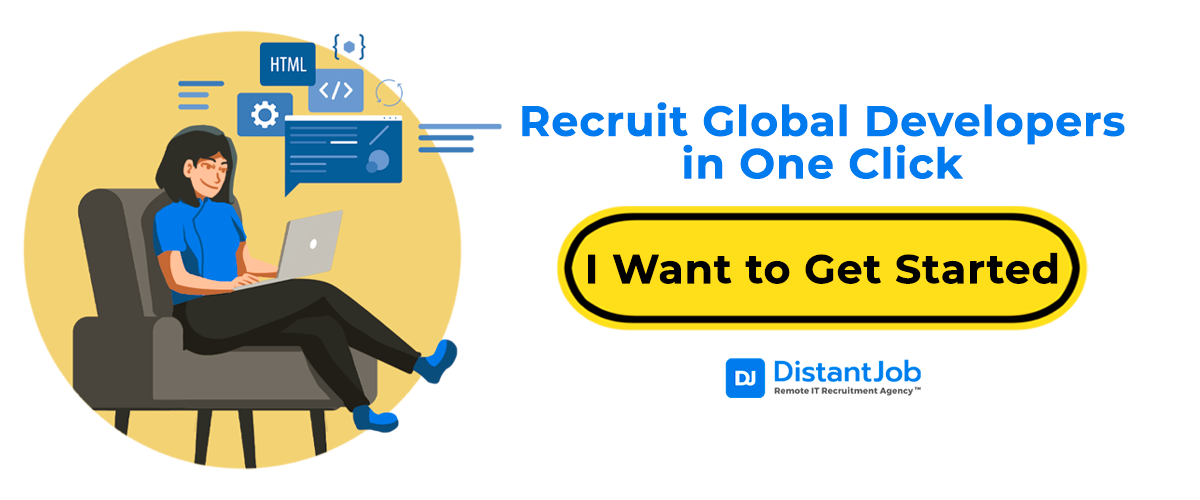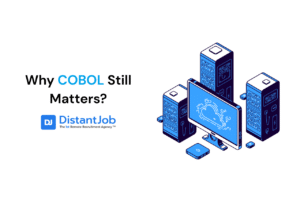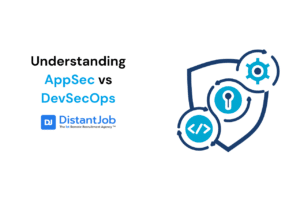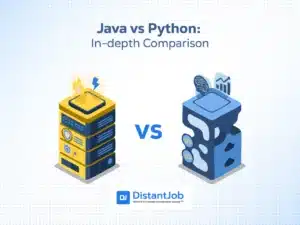Hybrid app development is a hot topic in the world of tech. Its popularity has grown mainly because it allows apps to be quickly built, less expensive, and work on several platforms and operating systems without requiring redoing the whole app from scratch.
Hybrid apps are not as widely used as native apps, but they have some great advantages that make them worth your consideration.
Given this, what is hybrid app development? In this article, we’ll discuss what hybrid application development is and why it might be right for you. We’ll also talk about the different stages of developing a hybrid app and which frameworks are best to use.
What is Hybrid App Development?
The hybrid app development methodology revolves around building an app with a single project using a framework that can target all needed platforms: Android, iOS, Windows, etc.
Hybrid software is very appealing because developers can create a single code base to be used for the app on all platforms. Except for some aspects of the app (the main one being the UI, which users expect to be tailored to their platform of choice), developers only need to write the code once, and then it can be reused when developing the app for any other target platform.
Two indisputable facts are driving the demand for hybrid apps: They’re easier to make than native applications, and their source code can be utilized to expand a business’ reach on multiple platforms, including the web.
Hybrid mobile app development is especially enticing for businesses because it allows them to enter the mobile market on all major platforms at once.
Why is a Hybrid App Different from a Native?
Hybrid development allows you to create your application once and then deploy it across different platforms, including iOS, Android, or Windows. This saves time for developers working on multiple projects designed specifically for each platform.
Developing apps with a hybrid mindset can be easier since the frameworks get updated regularly with new features, allowing developers to take advantage of specific features of certain platforms while maintaining a familiar development environment.
But this has the side effect of making the codebase generally larger, as it needs to account for all the different devices and OS versions that the app targets.
Native app development, on the other hand, is designed specifically for one platform and usually requires more time to develop. However, native apps typically perform better than hybrids because they have been specifically optimized for their target platform.
It comes down to your specific needs and what you want your app to do. If you only need to develop for one platform, or performance is a key factor for your app, you’ll probably want to develop a native app.
But if you need to develop for several platforms at once, and you’re looking for a cost-effective approach to your project, and you’re not concerned about having a few features that don’t perform as well on one platform versus the other, then hybrid app development might be the right option for you.
Best Hybrid App Frameworks
There are many hybrid app frameworks available today. Each framework has its strengths and weaknesses, so you need to choose the one that is best suited for your project.
1. React Native
React Native was first released by Facebook in 2015 and is a cross-platform mobile app development framework based on React. It’s an open-source Javascript framework that enables you to build multi-platform user interface components with JSX, which are then linked to native code and converted to Android and iOS native views.
The views are native components that communicate with logic written in JavaScript through a bridge. The code executes in a JavaScript thread.
2. Flutter
Flutter is an open-source framework developed by Google that uses a programming language of their own design, called Dart. It can deliver apps to mobile, web, desktop platforms, and even embedded devices.
Although it’s one of the more recent frameworks from this list, it has seen mass adoption from developers, mainly due to its competitive speed of development and the ability to use a wide array of widgets, some of which implement Google’s Material Design principles.
3. Apache Cordova
Apache Cordova is a cross-platform, open-source mobile development framework. It allows you to create mobile apps using standard web technologies. Apps developed with Apache Cordova run in the WebView within the native application wrapper.
4. Ionic
Ionic is a popular framework that uses HTML, CSS, and JavaScript to create hybrid mobile apps. It is very powerful, easy to use, and has built-in support for AngularJS, making it even more attractive for front-end developers who are already familiar with the framework.
5. Xamarin
Xamarin is a framework created by Microsoft for developing mobile apps built on top of their .NET framework and C# programming language. You can build apps and access native APIs for iOS, Android, and Windows.
It’s currently undergoing reform and will soon be consolidated into the .NET platform, becoming the .NET Multi-platform App UI (MAUI).
6. Unity
Unity can be considered a hybrid application framework, but its main use case is to develop games and other graphically demanding forms of entertainment (such as VR and AR experiences). It uses C# as its programming language.
It can be used to develop mobile and web apps, but they won’t have a native feel as easy as the other options in this list. However, if you’re looking to develop an entertainment app, it’s probably the best on the list.
Unity is also the most flexible: it can target Windows, Mac, Linux, iOS, Android, Web (through WebGL), some of the most popular Extended Reality kits (such as Oculus, Microsoft’s HoloLens, and PlayStation VR), and Consoles (such as Xbox, PlayStation, and Nintendo Switch).
Given these options, which hybrid app framework is best for you? It depends on your skill set, experience, and project requirements. React Native, Flutter, PhoneGap/Cordova, Ionic, and Xamarin are all great choices that should fit the needs of most developers.
Advantages of Hybrid Application Development
There are several advantages to using hybrid application development. One of the main benefits is using a mixture of technologies to create your app, which gives you more flexibility.
You’re not limited to just one platform or technology, so you can find the best tools for the job.
Additionally, a hybrid approach allows you to reach more users because your app will work on various devices. This is especially important if you want to target users who are not using the latest and greatest technology.
Finally, hybrid apps are typically faster and more responsive than traditional web apps, providing a better user experience.
That said, here are 7 other benefits of hybrid app development technologies:
1. Ease of Development
Hybrid apps are easier to develop than native apps because a developer does not need to know the language required by each platform.
Hybrid app development languages mostly revolve around web technologies (the triumvirate of HTML, CSS, and JavaScript), but C# is another popular candidate.
2. Maintainability
Hybrid applications offer developers a way of maintaining their code across multiple platforms with minimal effort. A single backend can power all of the apps, and updates to this backend can be pushed out quickly. This helps developers cut down on development time as they no longer need separate backends for each platform they support.
3. Performance
Hybrid applications are typically lighter than native applications because they all run within a single process and share memory space. Depending on how it’s developed, a hybrid application can also be more responsive than an app that is developed with native technologies.
4. Cross-Platform Compatibility
These applications are designed to run on multiple platforms at once. So they don’t have the same limitations as apps built specifically for one platform. This makes them ideal for businesses that want their presence to reach all their potential customers.
5. User Experience
A hybrid application can reuse components and design elements across platforms, which helps create a more consistent user experience. This can improve the brand image of an app because users will be exposed to the same look and feel no matter what platform they use it on.
6. Speed to Market
Developing a hybrid app can take significantly less time than developing a native app. This is especially true if you’re trying to develop an app for several platforms, where the code can be shared in its majority.
7. Cost-effective
Hybrid apps are typically more cost-effective than native apps, which can add up quickly if developed by an individual developer or a small team. By using hybrid web technologies, businesses can develop hybrid apps at a fraction of the cost of developing a native app.
Disadvantages of Hybrid Application Development
Hybrid app development is certainly beneficial in many aspects, but it also comes with its downsides. Here are some of the most important hybrid app development disadvantages you should take into account:
New features take a while to roll out
Hybrid app development frameworks are very flexible and useful, but they won’t always update as soon as any given feature is released on a specific platform. It usually takes a while for the developers to implement said features in the framework.
If you’re looking for bleeding-edge platform-specific technology, be sure your framework of choice supports it before committing to developing in it.
Lower Performance and Larger Size than Native Apps
Although the majority of these frameworks will usually be fast and most times compete with native applications in terms of performance, at the end of the day, a native app will almost always be more efficient.
Hybrid frameworks inevitably introduce overhead since they are using libraries and other code snippets to call native code, whereas a native app can do so directly.
These added libraries also introduce another disadvantage in the form of increased app size when installed.
Costs for Hybrid App Dev
No one can give you a flat price for hybrid software. But, it is less expensive than it would be to make a native mobile app. The cost might depend on how long it takes to make the app and what features or design you want on it.
Here is how much hybrid mobile apps of different complexity would cost:
- Basic hybrid mobile apps: These apps are less complicated, and developers can create them in a shorter amount of time. So they cost about $10,000.
- Mid-complex hybrid mobile apps: More advanced applications can cost anywhere from $10,000 to $50,000 and take 2-3 months to build.
- Enterprise hybrid mobile apps: They have a lot of features and are complicated applications that need more time to build. They take around 3-6 months to launch, costing anywhere from $50,000 to $150,000.
- Games: The most time-consuming applications to develop are games, which can cost up to $250,000 for hybrid app development services. Some firms may charge you by the hour, with hourly rates starting at around $50.
Top Hybrid Apps Examples
There are many hybrid apps in the market, but a few stand out from the rest. Let’s take a look at some of the best examples:
- Facebook: Facebook is one of the most popular hybrid apps in existence. Its mobile app was built using React Native, so it can run on any platform.
- Twitter: Twitter is another hybrid social media web app. It’s available on iOS, Android, Windows Phone, and more.
- Pinterest: Pinterest is a photo collection tool with over 100 million users worldwide. The service uses hybrid technology to get the most out of different devices while keeping its codebase light and easy to maintain.
- Airbnb: Airbnb is a popular travel and vacation rental service that was built using hybrid technology. It can be accessed on almost any platform, including iOS, Android, and Windows Phone. The company also partnered with Apple to launch an app for the Apple Watch.
- UberEATS: Uber launched its food delivery service, called UberEATS, using a hybrid app. It allows users to order food from their favorite local restaurants and has it delivered right to their doorstep.
- Spotify: This is another great example of how you can develop an application with hybrid applications while still providing the best user experience on any platform. The service was launched in 2008 and currently has over 100 million users worldwide.
- Uber: This is a ride-sharing app that connects passengers with drivers of vehicles for hire. It allows users to easily book their rides, track the car’s location and even pay online.
- Amazon App Store: This application helps you search products available on the Amazon website, find out product details, read reviews and make purchases.
- WixApp: This free app makes it easy for users to create their responsive website in just minutes without any coding skills needed.
Hybrid App Development: Stages
The development of hybrid apps is a mix of web technologies and native capabilities. Hybrid apps are built with the help of frameworks like PhoneGap or Ionic to render UI elements, so they can be displayed on devices as smoothly as a native app would do.
Let’s take a look at the different stages for developing a Hybrid app:
1. Pre-Development
In this stage, you need to determine whether hybrid app development is the right choice for your project. You also need to research the right technology stack and choose the right tools and frameworks.
2. Development
This is where you will write the Hybrid app development code. You will also need to use a cross-platform tool like PhoneGap or Ionic to build hybrid mobile apps. This stage also includes your UX/UI preparation, architectural development, and functionality development.
3. Testing
This is where you test your hybrid app development project (most likely a prototype) thoroughly before releasing it to production. This includes testing both the frontend and backend of your hybrid app development project.
4. Deployment
In this final stage, you deploy the hybrid mobile application to a specific platform or multiple platforms to be accessible by the end-users. You will either need to submit your hybrid app development project on respective app stores for Android/iOS devices or host them yourself on web servers.
5. Maintenance
Hybrid app development is a continuous process. With time, you will need to make changes in your hybrid mobile application according to your business requirements or release new versions with better functionalities.
This requires hybrid app developers to continuously perform bug fixes and enhancements on existing hybrid app projects throughout its life cycle. You also need to keep an eye on the latest hybrid app development trends and technologies to stay ahead of your competition during this stage.
How to Choose the Right Hybrid Mobile App Development for your Business?
There is no one-size-fits-all answer to this question. You need to consider the needs of your business and find an app development firm that can meet those needs.
Here are a few factors you should keep in mind when making your decision:
The Platforms Your App Will Run On
Not all app development firms have experience in building apps that run on all platforms. Make sure the firm you choose has experience in developing hybrid applications that will work on the devices your customers are using.
The Features Your App Will Have
Not all hybrid apps are created equal. Some developers specialize in developing simple, basic apps, while others focus on more complex applications. Make sure the developers you choose have the experience and expertise to build the features your app needs.
The Timeframe for Development
How long will it take for your app to be ready for launch? You need to consider this when making your decision.
The Cost
Hybrid app development is not cheap, but it’s still cheaper than developing a native app from scratch. Make sure you have a budget in mind and find a firm that can work within your budget.
The Level of Customer Service
How important is customer service to you? Make sure the app development firm you choose has a good reputation for providing quality customer service.
Get the Best Hybrid App Developers Now
To make the decision easier, DistantJob can help you find and recruit globally the best hybrid app developers for your business at half the cost and twice the speed. Contact us now for more details.






